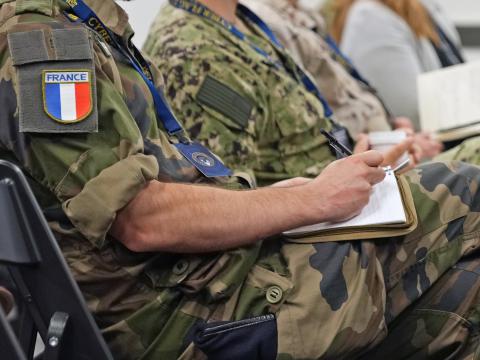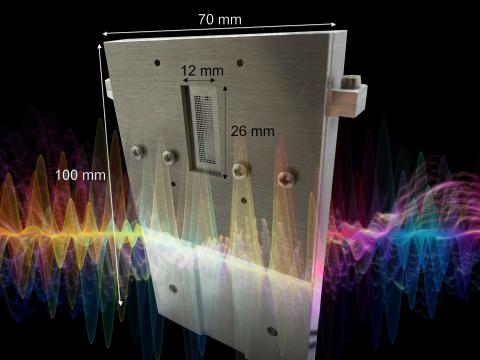Combat Surveillance Method Rolls Out Onto City Streets
Live video capabilities engaged by military intelligence units add to public safety arsenal for crime fighting, crowd control.
Military units and law enforcement personnel are employing the latest in integrated technology and real-time video transmission to conduct operations ranging from narcotics trafficking interdiction to search and rescue efforts. These mature yet evolving systems, used for several years to monitor the jungles of South America, are wending their way to new applications on the streets of Washington, D.C.
Simultaneous viewing by numerous personnel of real-time video will enhance surveillance operations designed to control crowds, apprehend criminals and assess hazardous material spills by allowing additional observers to examine a scene as it unfolds. By providing real-time information directly to decision makers, the system enables them to determine and carry out an appropriate course of action immediately. On the battlefield, the capability to gather information remotely reduces the number of personnel at risk and provides the commanders with instant data about changing situations.
Building on U.S. Army and National Guard reconnaissance mission success, the commercial video camera and transmitter/receiver system has been included in a comprehensive patrol car data gathering and management package. This system reduces the number of devices on the vehicle’s console and provides additional capabilities. It will enable law enforcement agencies in the capital area to complement audio and data exchanges with real-time video transmissions.
The ALERT system was developed under a project sponsored by the Federal Highway Administration. The agency tasked the Texas Transportation Institute with reviewing items that would make law enforcement personnel jobs easier by improving the efficiency and effectiveness of their tools. The institute is part of the Texas A&M University system, College Station, Texas.
A technical working group that consisted of law enforcement officers and data engineers from throughout the United States determined that officer safety was key and should be the initial focus of the work. “When riding with officers in patrol cars, we found that the vehicles had a lot of what we lovingly refer to as junk. We wanted to integrate all the peripherals into one touch screen,” G. Sadler Bridges, director, intelligent vehicle initiative, explains. The resulting ALERT system has been under construction for four years under the auspices of the institute.
The original design combined the standard equipment of a police vehicle, including lights, radio, radar, sirens and video recording. One 14-inch touch screen and a cellular telephone replaced the numerous pieces. These items are connected to the central processing unit, which features a standard data bus, located in the car’s trunk. Users access additional options for specific items by touching the appropriate icon.
Purchasing agencies provide the automobile. Bridges’ group then entirely guts the inside of the car, removing the carpets and seats so that the required wiring can be installed.
TAClink, a video relay system developed by Turtle Mountain Communications, Maryville, Tennessee, provides the live video portion of the system. It was added to the ALERT system design after a demonstration at a Federal Bureau of Investigation event last December. “We had been doing still photos and videotapes, but once live video was available through TAClink, customers wanted that too,” Bridges says. Real-time video capability was integrated into the ALERT system within a matter of weeks because the camera and multiplexer were already in place, he adds.
Designed to operate as a stand-alone unit or in conjunction with remote electro-optical and radar sensors, the real-time, full-motion video imagery system consists of a transmitter with a transmission range of up to 75 miles and a receiver. The system requires line-of-sight transmission.
Individual units of the system can be arranged in several configurations that are determined by the specific mission. For example, the video camera connected to the transmitter can be located in a fixed- or rotary-winged aircraft or ground vehicle. Because it is fully manportable, one soldier could carry this portion of the system in a manpack. The real-time video can then be sent to the receiver located on the ground, in another aircraft, or situated on an elevated landmass or structure. It also can be used with several types of sensors, including radar and forward looking infrared (FLIR) as well as image-intensified and low-light television cameras.
Additional features include a multisensor air-to-ground command and control link. Employing a digital datalink, the system controls the radar, receives radar target and system information and can command the airborne multisensor data display workstation from the ground to cue a FLIR sensor to survey areas of interest.
The distance the signal travels depends on the strength of the transmitter. A 20-watt transmitter can send video information up to 40 miles, while the 40-watt unit transmits the video up to 75 miles, Ed Busch, director of sales, Turtle Mountain Communications, says. Video can be either black and white or color, and a videocassette recorder allows the receiver to capture incoming video for transport or review, he adds.
Voice transmission is one way only, from the camera operator to the receiver. However, in the ALERT system, law enforcement personnel will be able to supplement voice communications with a cellular telephone.
The military has used TAClink for several years. The 204th Military Intelligence Battalion, Fort Bliss, Texas, purchased its first system in 1992 and has employed it in its U.S. Southern Command (SOUTHCOM) operations to provide live video from aerial imagery platforms to groundstations.
According to Maj. Adam R. Hinsdale, USA, battalion S-3 operations officer, TAClink has been primarily used in South America in support of a host nation’s riverine counternarcotics operations. The video camera and transmitter are placed onboard a DeHavilland-7 airplane for airborne reconnaissance low, or ARL, missions. The system’s receiving station is positioned on the host nation’s ship or land base where several law enforcement officers can simultaneously view the imagery in real time. If narcotics trafficking maneuvers are suspected, the live video feed allows officials to acquire information about the transport vehicles, including type, size, color and speed of travel. These data are then passed to the proper local authorities for action, Maj. Hinsdale explains.
SOUTHCOM is also employing the system during natural disasters to assess damage. Aircraft equipped with TAClink fly over communications lines such as roads and railroads to determine the extent of the destruction. Relief groups can then plan and execute operations.
These applications have produced substantial successful results because the system can send information directly to decision makers immediately, he adds.
Although the system does not feature encryption capabilities, the major says signal interception would be extremely difficult. Adversaries would have to learn both the frequency being used and the location of the receiving station and then set up their own receiving station near the site.
Because the system has a line-of-sight requirement, it cannot be used in the mountainous regions of South America. Battalion operations would be enhanced with a direct access satellite relay system, which would allow real-time video to be transmitted regardless of the terrain, Maj. Hinsdale offers.
TAClink also is being used in the United States by the National Guard in its war on drugs as well as in search and rescue missions. During the last four years, the District of Columbia Army National Guard has employed the system on a Bell JetRanger helicopter in support of local law enforcement, according to Capt. Berkley G. Gore, commander, reconnaissance and interdiction detachment.
“In the past, we had to take pictures from the air, then land and give the pictures to the appropriate person. Now they can see what’s going on at the same time. It gives the additional capability to allow more people to see what you’re seeing,” Capt. Gore explains.
Certain mission profiles call for TAClink’s use particularly when it is evident that it would be more beneficial than other means of gathering information, he says. In a search and rescue mission involving hazardous weather conditions, for example, TAClink concurrently provides additional observers for the search and allows pilots to concentrate on flying safety. During civil unrest, the system can provide real-time video to help assess where a buildup of people is occurring and which direction they are moving, he adds.
The District of Columbia Army National Guard unit has used the system in support of local law enforcement during large crowd activities such as the Million Man March. But with its recent purchase of one car equipped with the ALERT system, and with plans to take delivery of a second car, U.S. Park Police will soon be able to conduct additional missions of their own. TAClink also will be used in conjunction with helicopter surveillance, according to Lt. Noel Inzerille, commander, U.S. Park Police communications section.
Video images will be transmitted from the patrol car to a receiver site then downlinked to Park Police headquarters located in West Potomac Park. Among the receiver sites under consideration are the Washington Monument as well as several other tall structures in the area.
Lt. Inzerille believes the real-time video capability will increase effectiveness in crowd control and in the apprehension of fleeing suspects. “We will be able to patrol or search an area and better monitor a large event like the Fourth of July. We’re only using radios now, but with ALERT, we will be able to see what’s going on. During a chase, we will be able to put the helicopter up and follow the car. If the person leaves the car and goes out on foot, we will be able to pursue with information about where he’s going.”
The police department in Alexandria, Virginia, and the Secret Service have also purchased ALERT system-equipped cars.
Future deployment plans for the ALERT system featuring TAClink include a purchase by the Department of Transportation for vehicles to patrol the Interstate 95 corridor between Interstate 495 and Baltimore, Maryland. In addition, the system also may be installed in vehicles to monitor activity during the presidential inauguration in 2001 and the Olympics in 2002, Busch says.
While the intelligent vehicle initiative group is excited by the interest in the ALERT system, Bridges says it is not interested in producing the vehicles on a large scale. “We have only been involved in the design and research side. I would like to see someone commercialize this,” he adds.



